Clarence L. "Kelly" Johnson
Lockheed Aviation Legend - A Biography
1910-1990
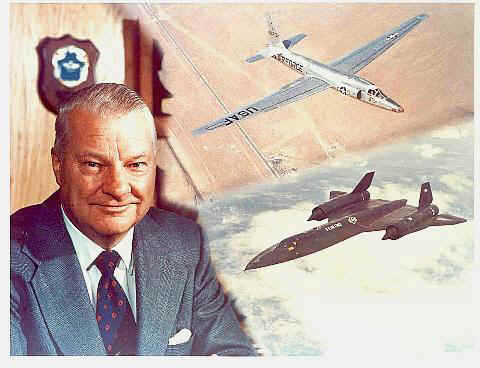
"Be Quick, Be Quiet, And Be On Time"
![]()
Copyrighted
June, 2000 by Leland Haynes, All Rights reserved
Clarence L. "Kelly" Johnson
Lockheed Aviation Legend - A Biography
1910-1990

"Be Quick, Be Quiet, And Be On Time"
![]()
Copyrighted
June, 2000 by Leland Haynes, All Rights reserved
Kelly Joins Lockheed:
Clarence
L. "Kelly" Johnson came to Lockheed in 1932 hunting a job. He was turned
down..insufficient experience. Johnson went back to school and obtained
a Master's Degree in Aeronautical Engineering. He came to Lockheed again
in 1933 and was hired as a tool designer. His salary was $83.00 per month
and became the sixth Engineer working for the fledgling Lockheed Company.
Then, as World War II approached, he helped the Company design the P-38,
America's first 400 mph airplane. After assignments as flight test engineer,
stress analyst, aerodynamicist, weight engineer, he became chief research
engineer in 1938. In 1952, Johnson was named chief engineer of Lockheed's
Burbank, California plant which later became the Lockheed-California Company.
When the office of corporate vice president-research and development was
established in 1956, he was chosen for the post. He became vice President-Advanced
Development Projects (ADP) (Skunk Works) in 1958, a member of the board
of directors in 1964 and a senior vice president of the corporation in
1969. He officially retired from Lockheed in 1975 but continued as a consultant
to the Skunk Works and the Lockheed projects. Kelly left the Board of Directors
in 1980. In June of 1983, the name of the 500 acre Lockheed Rye Canyon
Research facility was renamed Kelly Johnson Research and Development Center,
Lockheed-California Company, in his honor for 50 years of service to Lockheed.
Accomplishments: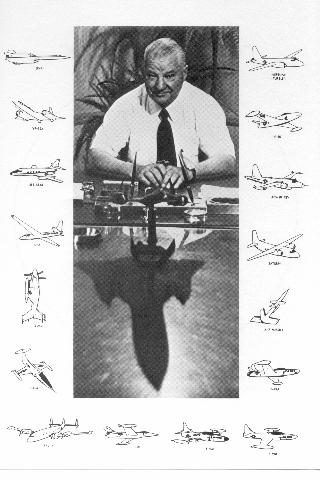
Johnson has played a leading role in the design of 40 world renowned aircraft. Of these more than half were of his original design. Among them the F-80, America's first production jet; the double-sonic F-104 Starfighter; the high altitude U-2 and the spectacular 2,000 MPH YF-12A and the SR-71.
He contributed to the design of the first plane with power controls, the F-90 Interceptor.
Kelly designed single-handedly the Lockheed Hudson Bomber at the age of 29. Traveling to England with Courtland Gross, A Lockheed director, the British nixed the original design. Johnson recalls: "They told us the bombs had to go under the floor, that they needed forward shooting guns and dozens of other things." "So, I redesigned the airplane in my hotel room in a couple of days according to British specifications." Johnson's design landed Lockheed an order for 200 planes, the largest order that had ever been placed in the U.S. during peacetime. In all, Lockheed built 3,500 Hudson's for the U.K. by the end of World War II.
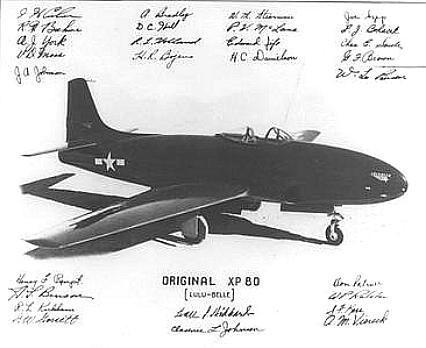 XP-80
On
January 8, 1944, the late Milo Burcham about to climb into the cockpit
of the XP-80, Lockheed's first jet, turned to project chief Kelly Johnson
for instructions. "Find out if she's a lady or a witch." said Johnson.
She was a lady, appropriately nicknamed Lulu-Belle. She was built in just
143 days after Air Corps go-ahead. Principal designers and managers of
Lulu-Belle autographed this photo of the XP-80. Kelly Johnson's autograph
is center bottom.
XP-80
On
January 8, 1944, the late Milo Burcham about to climb into the cockpit
of the XP-80, Lockheed's first jet, turned to project chief Kelly Johnson
for instructions. "Find out if she's a lady or a witch." said Johnson.
She was a lady, appropriately nicknamed Lulu-Belle. She was built in just
143 days after Air Corps go-ahead. Principal designers and managers of
Lulu-Belle autographed this photo of the XP-80. Kelly Johnson's autograph
is center bottom.
![]()
Kelly Johnson's Designs and Contributions to Lockheed Aircraft
He
designed and built the following aircraft:
(click on the model for a picture)
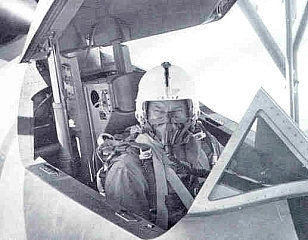
Kelly flew in the YF-12A Trainer
![]()
Childhood and Education:
"I
knew I wanted to design airplanes when I was 12 years old" says Johnson.
"I read every Tom Swift novel I could get my hands on. I read "Tom Swift
and his Airplane"; "Tom Swift and his Electric Car" ; "Tom Swift and his
Submarine" and I said that's for me." A native of Michigan, Johnson was
born in the remote mining town of Ishpeming on February 27, 1910 to immigrant
Swedish parents. Kelly was born seven years after the Wright Brothers made
their first successful flight. After making his decision at the age of
12 to design aircraft, he went ahead to design his first airplane. Kelly
called his first design "The Merlin 1, Battle Plane". Several weeks later
he saw
his first airplane; a World War I Jenny. His decision was
confirmed. He later moved to Flint where his father had a construction
business. Kelly graduated from Flint High School, working summers with
his father and in the motor test section of the Buick Motor Car Company.
By graduation he had saved up $300. He tried to give it to an Instructor
at the Flint Airport in exchange for flying lessons, but the Instructor
shook his head and probably changed the entire course of Kelly's life.
"I've always had the greatest respect for that man," Kelly said later.
"He needed that money more than anything else in the world. But instead
of taking it, he said, "Look kid..save that money and go to school." Kelly
did. He graduated from Flint Junior College and completed his education
at the University of Michigan, where he received His Bachelor of Science
Degree in 1932. Kelly Johnson worked his way through school by picking
up scholarships, washing dishes and helping a professor; Edward Stalker, as a Teaching Assistant.
He went on to received his Master of Science Degree in Aeronautical Engineering
in 1933. During this period he picked up small teaching fellowships and
augmenting his income by renting the University's wind tunnel to run tests
as a consultant on models of Indianapolis racing cars, trains and aircraft.
"I made more more money that year than any of the first 10 years I worked
for Lockheed." Kelly grins.
![]()
Honors:
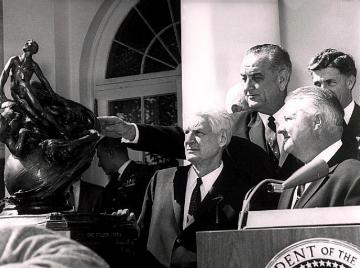 Many
honors have come to him for his unique contributions to aerospace development
through the years and to the defense of the United States and the Free
World. Among these, Mr. Johnson has won the Collier Trophy twice.
In 1958 to: The United States Air Force and Industry Team Responsible for
the F-104 Interceptor; Clarence L. Johnson of Lockheed Aircraft Corporation
for the design of the airframe. In 1963 to: Clarence L. "Kelly" Johnson
For designing and directing the development of the USAF A-11 Mach 3 aircraft.
Many
honors have come to him for his unique contributions to aerospace development
through the years and to the defense of the United States and the Free
World. Among these, Mr. Johnson has won the Collier Trophy twice.
In 1958 to: The United States Air Force and Industry Team Responsible for
the F-104 Interceptor; Clarence L. Johnson of Lockheed Aircraft Corporation
for the design of the airframe. In 1963 to: Clarence L. "Kelly" Johnson
For designing and directing the development of the USAF A-11 Mach 3 aircraft.
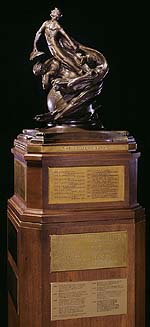 The
Collier Trophy (right) was established in 1911 by Robert J. Collier,
publisher and early President of the Aero Club of America. The trophy is
administered by the National Aeronautic Association of the U.S.A. and is
awarded annually for "the greatest achievement in aeronautics or astronautics
in America, with respect to improving the performance, efficiency, and
safety of air or space vehicles, the value of which has been thoroughly
demonstrated by actual use during the preceding year.
The
Collier Trophy (right) was established in 1911 by Robert J. Collier,
publisher and early President of the Aero Club of America. The trophy is
administered by the National Aeronautic Association of the U.S.A. and is
awarded annually for "the greatest achievement in aeronautics or astronautics
in America, with respect to improving the performance, efficiency, and
safety of air or space vehicles, the value of which has been thoroughly
demonstrated by actual use during the preceding year.
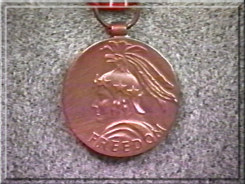 On
September 14, 1964 President Lyndon B. Johnson presented to Clarence L.
Johnson the Medal of Freedom, the highest civil honor the President
can bestow. "Kelly Johnson and the products of his famous Skunk Works epitomize
the highest and finest goal of our society, the goal of excellence. His
record of design achievement in aviation is both incomparable and virtually
incredible. Any one of his many airplane designs would have honored any
individual's career." President Lyndon B. Johnson.
On
September 14, 1964 President Lyndon B. Johnson presented to Clarence L.
Johnson the Medal of Freedom, the highest civil honor the President
can bestow. "Kelly Johnson and the products of his famous Skunk Works epitomize
the highest and finest goal of our society, the goal of excellence. His
record of design achievement in aviation is both incomparable and virtually
incredible. Any one of his many airplane designs would have honored any
individual's career." President Lyndon B. Johnson.
The citation to accompany the Medal of Freedom read:
"Aeronautical engineer, his genius for conceiving unique airframes and
his
technical management skills contribute mightily to the Nation's security
by
creating aircraft of daring design with unmatched rapidity and
effectiveness."
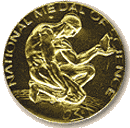 The
National
Medal of Science was awarded to Kelly Johnson in 1966 by President
Lyndon B. Johnson. Given to individuals "deserving of special recognition
by reason of their outstanding contributions to knowledge in the physical,
biological, mathematical, or engineering sciences".
The
National
Medal of Science was awarded to Kelly Johnson in 1966 by President
Lyndon B. Johnson. Given to individuals "deserving of special recognition
by reason of their outstanding contributions to knowledge in the physical,
biological, mathematical, or engineering sciences".
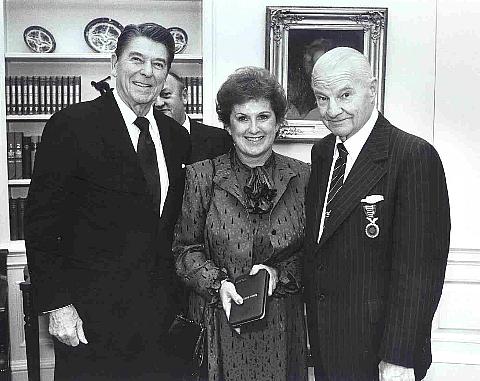 On
October 06,1983, President Ronald Reagan presented Clarence L."Kelly" Johnson
The National Security Medal. It was the first time an aeronautical
engineer had been awarded the medal. In White House ceremonies the medal
was presented for "Exceptional meritorious service performed in a position
of high responsibility and have made an outstanding contribution to the
National Security of the Nation". (Photo insert shows Kelly's wife Nancy).
During an informal moment, Kelly mentioned to the President that they were
California neighbors; both having ranches In Santa Barbara County. "But,
there's a difference in the two ranches", Reagan smiled. "Yours has heat".
The Reagan ranch house depended on wood burning fireplaces for warmth.
On
October 06,1983, President Ronald Reagan presented Clarence L."Kelly" Johnson
The National Security Medal. It was the first time an aeronautical
engineer had been awarded the medal. In White House ceremonies the medal
was presented for "Exceptional meritorious service performed in a position
of high responsibility and have made an outstanding contribution to the
National Security of the Nation". (Photo insert shows Kelly's wife Nancy).
During an informal moment, Kelly mentioned to the President that they were
California neighbors; both having ranches In Santa Barbara County. "But,
there's a difference in the two ranches", Reagan smiled. "Yours has heat".
The Reagan ranch house depended on wood burning fireplaces for warmth.
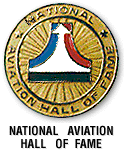 The
Aviation
Hall of Fame
The
Aviation
Hall of Fame
in
Dayton, Ohio enshrined Johnson in 1974.
He
created innovative technical concepts
that
significantly advanced aircraft design, performance, and reliability.
He
helped design Lockheed P-38, T-33, U-2, and SR-71 aircraft.
He
helped achieve supersonic flight and spaceflight.
In 1975, Kelly won the Wright Brothers Trophy. It is awarded annually by the National Aeronautic Association of the U.S.A. to a living American in recognition of significant service of enduring value to aviation in the U.S. This original trophy was entrusted to the Smithsonian Institution by the National Aeronautic Association of the U.S.A., which each year presents a replica to the recipient on the anniversary of the historic first flight at Kitty Hawk, N.C.
Mr. Johnson has also received two Sylvanus Albert Reed Awards, one in 1956 and again in 1966. The Reed Aeronautics Award is the highest award an individual can receive for achievements in the field of aeronautical science and engineering. The award is named after Dr. Sylvanus A. Reed, the aeronautical engineer, designer, and founding member of the Institute of Aeronautical Sciences.
He won the Von Karman Award (twice). One in 1963 and again in 1964.
At the age of 71, Kelly Johnson was the 1981 recipient of the Daniel Guggenheim Award for "His brilliant design of a wide range of pace-setting, commercial, combat and reconnaissance aircraft, and for his innovative management techniques which developed these aircraft in record time at minimum cost". The first winner of the Guggenheim Medal, "Honoring persons who make notable achievements in the advancement of aeronautics", was Orville Wright in 1929.
Awarded the 5th Annual Howard R. Hughes Memorial Award by the Aero Club of Southern California in 1983.
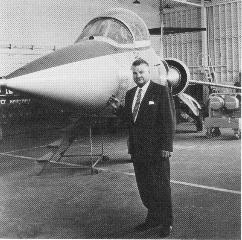
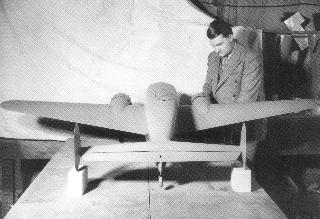
Kelly with the Lockheed F-104 Starfighter and with a mockup of the
Model 10 Electra
![]()
Kelly Johnson's 14 Rules of Management
1.The Skunk Works manager must be delegated practically complete control of his program in all aspects. He should report to a division president or higher.
2.Strong but small project offices must be provided both by the military and industry.
3.The number of people having any connection with the project must be restricted in an almost vicious manner. Use a small number of good people (10% to 25% compared to the so-called normal systems).
4.A very simple drawing and drawing release system with great flexibility for making changes must be provided.
5.There must be a minimum number of reports required, but important work must be recorded thoroughly.
6.There must be a monthly cost review covering not only what has been spent and committed but also projected costs to the conclusion of the program. Don't have the books ninety days late and don't surprise the customer with sudden overruns.
7.The contractor must be delegated and must assume more than normal responsibility to get good vendor bids for subcontract on the project. Commercial bid procedures are very often better than military ones.
8.The inspection system as currently used by the Skunk Works, which has been approved by both the Air Force and Navy, meets the intent of existing military requirements and should be used on new projects. Push more basic inspection responsibility back to subcontractors and vendors. Don't duplicate so much inspection.
9.The contractor must be delegated the authority to test his final product in flight. He can and must test it in the initial stages. If he doesn't, he rapidly loses his competency to design other vehicles.
10. The specifications applying to the hardware must be agreed to well in advance of contracting. The Skunk Works practice of having a specification section stating clearly which important military specification items will not knowingly be complied with and reasons therefore is highly recommended.
11. Funding a program must be timely so that the contractor doesn't have to keep running to the bank to support government projects.
12. There must be mutual trust between the military project organization and the contractor with very close cooperation and liaison on a day-to-day basis. This cuts down misunderstanding and correspondence to an absolute minimum.
13. Access by outsiders to the project and its personnel must be strictly controlled by appropriate security measures.
14.
Because only a few people will be used in engineering and most other areas,
ways must be provided to reward good performance by pay not based on the
number of personnel supervised.
![]()
Kelly Johnson's Honors and Awards 1932 to 1984
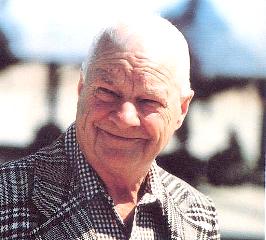

Kelly's Student License and Flight Record
(Photos Courtesy of the Johnson Family Collection)
Kelly Johnson's Student Pilot Certificate
Kelly Johnson's Flight Log
Family:
Kelly Johnson was first married to Althea Louise Young in 1937. Althea passed away in December 1969. His second marriage was to the former Maryellen Elberta Meade of New York state in May 1971. Maryellen passed away on October 13, 1980. She was only 38 years old. They had a home in Encino, California and a ranch near Santa Barbara, California. Mr. Johnson later married the former Nancy Powers Horrigan in November, 1980. They had resided in Encino, California. Johnson had triple heart bypass surgery for a cardiac problem.
![]()
Quotes:
About
How Clarence L.Johnson became "Kelly":
Kelly Recalls: While attending grade school, I was chided by some classmates for my name; Clarence. The other boys started calling me "Clara". One morning while waiting in line to get into a classroom, one boy named Cecil started with the normal routine of calling me "Clara". I then tripped the boy so hard it broke his leg. The boys then decided that I wasn't a "Clara" and looking for a new nickname started calling me "Kelly". The nickname came from the popular song at the time.."Kelly With the Green Neck Tie". From that time forward it would always be "Kelly Johnson".
About Howard Hughes, Kelly recalls:
"I remember working with Howard Hughes in 1957, when he was ordering Constellations for TWA airlines. He was a night owl and he demanded we meet in the ballroom of the Beverly Hills Hotel at 11 PM. He had six of his goons stationed around the ballroom to make sure no one listened. We'd work through the night making little changes here and there. It nearly destroyed my health because I was also working during the day on the U-2 and the F-104."
About
U.S. Defense Department's Cancellation of the F-12B
The
Russian Backfire Bomber had just came out and Kelly comments: "Of course
we do need such a plane (F-12B Fighter Interceptor similar to the SR-71)
now...and we don't have it. It just shows that you can be right and still
lose the ball game."
About
Building the SR-71:
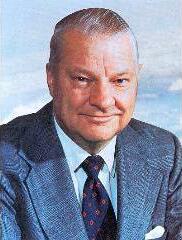 "It
was no easy task. Everything about the SR-71 had to be invented from scratch...the
design, the technology, even the materials. I offered a $50 reward to anyone
who could come up with an easy answer. I still have the $50." "During
the program we were able to reduce the cost of a foot of a particular type
of Titanium extrusion from $119 to $11." He said proudly. "And we dropped
the cost of a particular Titanium bolt from $15 to .25 cents. In the words
of Kelly Johnson, "It makes no sense to just take this one or two steps
ahead, because we'd be buying only a couple of years before the Russians
would be able to nail us again. No, I want us to come up with an airplane
that can rule the skies for a decade or more." He wanted to design an airplane
that used conventional engines and fuel, but still be able to outrace any
missile.
"It
was no easy task. Everything about the SR-71 had to be invented from scratch...the
design, the technology, even the materials. I offered a $50 reward to anyone
who could come up with an easy answer. I still have the $50." "During
the program we were able to reduce the cost of a foot of a particular type
of Titanium extrusion from $119 to $11." He said proudly. "And we dropped
the cost of a particular Titanium bolt from $15 to .25 cents. In the words
of Kelly Johnson, "It makes no sense to just take this one or two steps
ahead, because we'd be buying only a couple of years before the Russians
would be able to nail us again. No, I want us to come up with an airplane
that can rule the skies for a decade or more." He wanted to design an airplane
that used conventional engines and fuel, but still be able to outrace any
missile.
About
Designing Aircraft:
"If
I didn't get the Hell scared out of me once a year, I would not have the
proper balance to design future aircraft".
About the J-58
Engine:
Shortly after development commenced, a wager was opened between Kelly Johnson and Bill Brown, over which
of the two companies would succeed in producing the best fuel-injection system for the aircraft. It was settled that
the loser would have to carry the costs for use of the wind-tunnel, which Brown estimated would be about
$12,000. Pratt & Whitney won and true to his promise, Kelly Johnson sent a check of sufficient value. The event
was used to play a prank. Bill Brown acquired a complete naval sailor's uniform, with cap and blue jacket, and thus
attired had himself photographed in front of the 12.5
meters long private yacht of Bill Gordon. He sent the photograph to Johnson with the comment "thanks for the
check". The photograph hung for many years afterwards on the wall of Lockheed's staff reunion room.
About
UAV's:
"Fighters
will get rid of the men and become drones with the ability to do everything
a man-operated plane can do."
![]()
The
Skunk Works beginning:
During
World War II, Johnson set up the Skunk Works after receiving approval from
the U.S. Air Corps to build a jet fighter (the F-80 Shooting Star). Johnson
recalls, "At the time, space was scarce because Lockheed was busy building
17 P-38's a day; 4 B-17's; 6 versions of the Hudson and the Lodestar, for
a total of about 28 planes a day." So Johnson had a new space created for
him in the old China Factory plant at B-1 next to a wind tunnel using Wright
engine packing boxes for walls and a circus tent for a roof. Under these
conditions, he laid out a design for a new fighter for an Air Corps competition.
It won. It became the F-80 Shooting Star. 
Security
was so tight on the project, people around Lockheed began to wonder what
Johnson was doing in his makeshift headquarters. One day, someone suggested
he was stirring up some sort of brew....evoking images of the Kickapoo
Joy Juice made by Al Capp's comic strip characters in Dogpatch's "Skonk
Works". The Name "Skunk Works" stuck. And so did the Skunk Works reputation
for building advanced aircraft under super-secret conditions. Secrecy was
maintained, according to Kelly, because he doled out only portions of the
projects to his staff and kept the over-all plans to himself. Under these
conditions, Kelly later on built the first U-2 in a mere eight months.
![]()
Quotes about Kelly from others:
Ben
Rich:
Kelly
disliked long written reports, so he limited any report addressed to him
to a length no longer than 20 pages. Kelly said, "I don't have time to
read long reports of anything". He also limited meetings to 15 people or
less.
Soviet
Mig Pilot Belinko Recalls:
Chasing
the SR-71 along the Siberian Coast in a Mig-25, I could not match it's
speed. One flight in the Mig-25 and we had to change our engines. I could
not believe that such technologies existed.
In
a memo dated November 1974, announcing Kelly's imminent retirement, Lockheed
Corporate
President Carl Kotchian summarized Mr. Johnson's career as follows:
Carl
described Kelly's early accomplishments; the P-38 Lightening; the Hudson
Bomber and the XP-80 Shooting Star. He went on to say:
"But
these are only crumbs from the cake of Kelly's genius. He has performed
Herculean tasks many, many times since...always living up to his motto:
"Be quick, be quiet, and be on time". It is Kelly as a person I think we
will miss most...His absolute honesty, his dedicated patriotism(
he may be the most honored engineer in history, but many of the things
he has done for his country will never be told), and his unswerving support
for people who worked for him." "It
is not probable that we will see Kelly's like again," Kotchian concluded.
"We can all be grateful that he picked Lockheed as the place to do his
work and make his contribution to aviation."
Kelly
Johnson Dies;
Johnson died on December 21, 1990 at St Joseph Medical Center after
an illness of many years. Kelly is buried at Forest Lawn (Hollywood
Hills), Los Angeles, California.
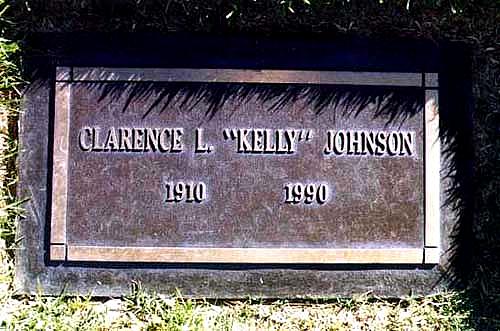
Kelly Johson Image Archive Link:
20
Images of Kelly courtesy of Lockheed Martin Corporation
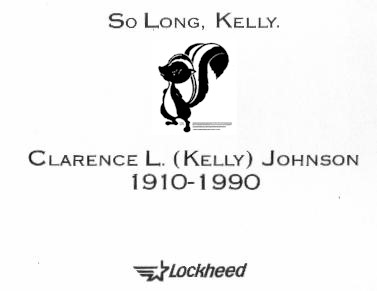
![]()
| SR-71 Front Page | Links Page | Index Page | Recollections | 2001 Reunion |
| "SR-71 Blackbirds" Web Site Navigator | ||||
| First Created: April 15, 1996 - Last Revised: July 30, 2005 | ||||
| Copyright © 1996 Leland R. Haynes Email: sr71webmaster@sr71.us | ||||
This
web page is ![]() Copyrighted
on June 29, 2000. Revised on July 30, 2005. This web site is Copyrighted
property of Leland Haynes, Webmaster, SR-71
Blackbirds. All rights reserved. May not be reproduced in any format.
Skunk logo is copyrighted property of Lockheed Martin Corporation.
Image kickapoo.jpg is copyrighted property of:
Capp Enterprises, Inc. corporate offices c/o Broude & Hochberg, L.L.P.,
75 Federal Street, Boston, Massachusetts, 02110 Images: kelly's_license.jpg and
kelly's_fltrecord.jpg are the property of the Kelly Johnson Family Estate.
Copyrighted
on June 29, 2000. Revised on July 30, 2005. This web site is Copyrighted
property of Leland Haynes, Webmaster, SR-71
Blackbirds. All rights reserved. May not be reproduced in any format.
Skunk logo is copyrighted property of Lockheed Martin Corporation.
Image kickapoo.jpg is copyrighted property of:
Capp Enterprises, Inc. corporate offices c/o Broude & Hochberg, L.L.P.,
75 Federal Street, Boston, Massachusetts, 02110 Images: kelly's_license.jpg and
kelly's_fltrecord.jpg are the property of the Kelly Johnson Family Estate.
Page #38 of "The SR-71 Blackbirds"